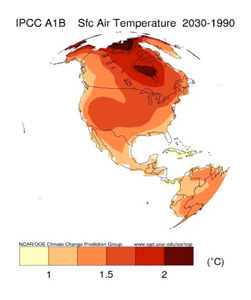
> Read more about Current Activities & Accomplishments
> Read more about Impacts of Hydrology and Climate Modeling
A central research challenge of NM EPSCoR is to understand how future changes in seasonal temperature and precipitation will impact snowpack, snowmelt and spring runoff in the mountainous region of north central New Mexico. This region, the southernmost extent of the Rocky Mountain range, serves as the headwaters for river systems of crucial importance to NM, including the Rio Grande. NM EPSCoR research efforts focus on upgrading and expanding climate and hydrology observing networks and improving hydrologic and climate models to better investigate questions in the study region.
The hydrologic impacts of warming trends on mountain sources of water are projected to include later seasonal transition from rain to snow, higher snow line, less total snowpack, earlier snowmelt in springtime, and increased evapotranspiration (ET) rates in the warm season. NM EPSCoR investments to expand climate and hydrology observational networks throughout the state provide the watershed data collection network and the coupled atmosphere-land surface-hydrology modeling capability needed to examine and understand these processes.
NM EPSCoR researchers at UNM, NM Tech, and NMSU are working on several climate-related modeling efforts concurrently. They are using and improving hydrological models for short-term forecasting as well as long-term assessments of possible climate impacts. Other researchers are developing a better understanding of the underlying processes that govern climate variability globally, especially in arid and semi-arid regions, that can inform global climate models.
The resulting data collection and modeling capability will lead to improved streamflow projections needed by resource mangers and policymakers to make decisions related to water resource allocations for urban, agricultural and other uses.
NM EPSCoR Hydrology & Climate Modeling Participants:
- John Wilson, NMT
- Joe Galewsky, UNM
- Al Rango, NMSU
- Caiti Steele, NMSU
- Marty Frisbee, NMT
- Jesus Gomez, NMT
- Bayani Cardenas, NMT




